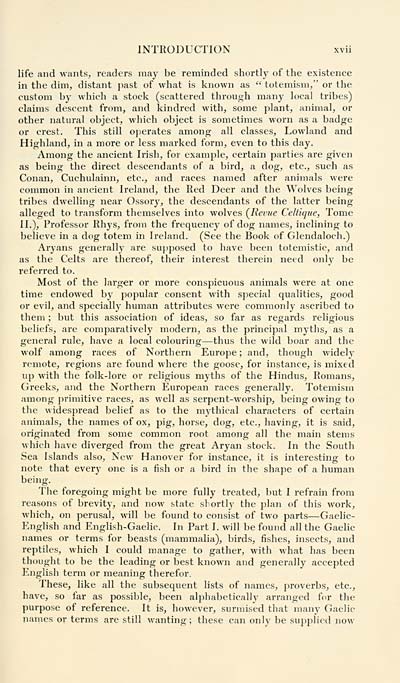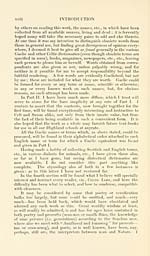Download files
Complete book:
Individual page:
Thumbnail gallery: Grid view | List view

INTRODUCTION xvii
life and wants, readers may be reminded shortly of the existence
in the dim, distant past of what is known as " totemisni," or the
custom by which a stock (scattered through many local tribes)
claims descent from, and kindred with, some plant, animal, or
other natural object, which object is sometimes worn as a badge
or crest. This still operates among all classes, Lowland and
Highland, in a more or less marked form, even to this day.
Among the ancient Irish, for example, certain parties are given
as being the direct descendants of a bird, a dog, etc., such as
Conan, Cuchulainn, etc., and races named after animals were
common in ancient Ireland, the Red Deer and the Wolves being
tribes dwelling near Ossory, the descendants of the latter being-
alleged to transform themselves into wolves (Revue CeUique, Tome
II.), Professor Rhys, from the frequency of dog names, inclining to
believe in a dog totem in Ireland. (See the Book of Glendaloch.)
Arjans generally are supposed to have been totemistic, and
as the Celts are thereof, their interest therein need only be
referred to.
Most of the larger or more conspicuous animals were at one
time endowed by popular consent with special qualities, good
or evil, and specially human attributes were commonly ascribed to
them ; but this association of ideas, so far as regards religious
beliefs, are compai'atively modern, as the principal myths, as a
general rule, have a local colouring — thus the wild boar and the
wolf among races of Northern Europe; and, though widely
remote, regions are found where the goose, for instance, is mixed
up with the folk-lore or religious myths of the Hindus, Romans,
Greeks, and the Northern European races generally. Totemism
among primitive races, as well as serpent-worship, being owing to
the widespread belief as to the mythical characters of certain
animals, the names of ox, pig, horse, dog, etc., having, it is said,
originated from some common root among all the main stems
which have diverged from the great Aryan stock. In the South
Sea Islands also, New Hanover for instance, it is interesting to
note that every one is a fish or a bird in the shape of a human
being.
The foregoing might be more fully treated, but I refrain from
reasons of brevity, and now state shortly the plan of this work,
which, on perusal, will be found to consist of two parts — Gaelic-
English and English-Gaelic. In Part I. will be found all the Gaelic
names or terms for beasts (mammalia), birds, fishes, insects, and
reptiles, which I could manage to gather, with what has been
thought to be the leading or best known and generally accepted
English term or meaning therefor.
These, like all the subsequent lists of names, proverbs, etc.,
have, so far as possible, been alphabetically arranged for the
purpose of reference. It is, however, surmised that many Gaelic
names or terms are still wanting ; these can only be supplied now
life and wants, readers may be reminded shortly of the existence
in the dim, distant past of what is known as " totemisni," or the
custom by which a stock (scattered through many local tribes)
claims descent from, and kindred with, some plant, animal, or
other natural object, which object is sometimes worn as a badge
or crest. This still operates among all classes, Lowland and
Highland, in a more or less marked form, even to this day.
Among the ancient Irish, for example, certain parties are given
as being the direct descendants of a bird, a dog, etc., such as
Conan, Cuchulainn, etc., and races named after animals were
common in ancient Ireland, the Red Deer and the Wolves being
tribes dwelling near Ossory, the descendants of the latter being-
alleged to transform themselves into wolves (Revue CeUique, Tome
II.), Professor Rhys, from the frequency of dog names, inclining to
believe in a dog totem in Ireland. (See the Book of Glendaloch.)
Arjans generally are supposed to have been totemistic, and
as the Celts are thereof, their interest therein need only be
referred to.
Most of the larger or more conspicuous animals were at one
time endowed by popular consent with special qualities, good
or evil, and specially human attributes were commonly ascribed to
them ; but this association of ideas, so far as regards religious
beliefs, are compai'atively modern, as the principal myths, as a
general rule, have a local colouring — thus the wild boar and the
wolf among races of Northern Europe; and, though widely
remote, regions are found where the goose, for instance, is mixed
up with the folk-lore or religious myths of the Hindus, Romans,
Greeks, and the Northern European races generally. Totemism
among primitive races, as well as serpent-worship, being owing to
the widespread belief as to the mythical characters of certain
animals, the names of ox, pig, horse, dog, etc., having, it is said,
originated from some common root among all the main stems
which have diverged from the great Aryan stock. In the South
Sea Islands also, New Hanover for instance, it is interesting to
note that every one is a fish or a bird in the shape of a human
being.
The foregoing might be more fully treated, but I refrain from
reasons of brevity, and now state shortly the plan of this work,
which, on perusal, will be found to consist of two parts — Gaelic-
English and English-Gaelic. In Part I. will be found all the Gaelic
names or terms for beasts (mammalia), birds, fishes, insects, and
reptiles, which I could manage to gather, with what has been
thought to be the leading or best known and generally accepted
English term or meaning therefor.
These, like all the subsequent lists of names, proverbs, etc.,
have, so far as possible, been alphabetically arranged for the
purpose of reference. It is, however, surmised that many Gaelic
names or terms are still wanting ; these can only be supplied now
Set display mode to: Large image | Transcription
Images and transcriptions on this page, including medium image downloads, may be used under the Creative Commons Attribution 4.0 International Licence unless otherwise stated. ![]()
| Early Gaelic Book Collections > Blair Collection > Gaelic names of beasts (mammalia), birds, fishes, insects, reptiles, etc > (23) |
|---|
| Permanent URL | https://digital.nls.uk/79329523 |
|---|
| Description | A selection of books from a collection of more than 500 titles, mostly on religious and literary topics. Also includes some material dealing with other Celtic languages and societies. Collection created towards the end of the 19th century by Lady Evelyn Stewart Murray. |
|---|
| Description | Selected items from five 'Special and Named Printed Collections'. Includes books in Gaelic and other Celtic languages, works about the Gaels, their languages, literature, culture and history. |
|---|

